By Dr Fiona Aubrey-Smith
As you look ahead to 2023, how are the decisions made about using digital technologies in your classrooms shaping the skills and awareness of your students to live in a globalised world?
From a digital technology perspective, the landscape that our students are living in includes students whose education has been under-connected, through to those who are hyper-digitalised and globally astute. Some teachers use technologies within their teaching to share resources on demand, engage students through audio-visual experiences and extend learning through interactive activities. Some teachers put the technologies in the hands of students who complete tasks more efficiently, communicate their understanding more inclusively, connect their knowledge more precisely and collaborate with others more impactfully.
Yet in all classrooms, the single biggest influence will be the capabilities and confidence of the teacher. We are the gatekeepers of children’s experiences. As a leader, this will be on your radar already. The question you will be asking is what we can do to improve it.
A strategy for change
Let me introduce you to the 3Cs: Cognisance, Competence and Confidence. These break down ‘what a teacher can do’ into smaller, precise and more manageable components that we can build up in stages.
- Cognisance – what we are aware of and understand
- Competence – what we are skilled in doing in practice
- Confidence – how much we feel capable of doing
If we reflect on the professional learning that we put in place for teachers relating to digital technologies, most of the emphasis tends to be on raising awareness about what to use and how to use it (ie, ‘training’). Teachers are often then encouraged to implement ideas with competence and confidence assumed to follow automatically. We can do better.
The 3Cs strategy provides a simple model which can be used as part of team meetings. For each of the 3Cs, there is:
- an entry task (15–30 minutes)
- an ongoing activity (10–30 minutes)
The actions are for individual teachers to complete, but the sharing and discussion aspects bring these actions together for everyone’s benefit. All tasks focus on reflection for each individual teacher, ensuring an individualised and active approach to professional learning.
Build Cognisance
Help teachers become aware of, and understand, the potential of relevant, and specific, digital technologies.
Entry task:
Engage teachers in thinking about the digital devices and processes they engage with beyond their school and ‘why’ these are popular or impactful.
- ‘On-demand TV’ – about individualised content based on previous activity – try to draw out the parallels with formative assessment
- ‘Customer ratings and reviews’ – provide peer judgement against mutually recognised criteria – try to draw out the parallels with peer assessment and success criteria
Intended outcome:
This helps teachers see the ways that everyday technologies affect behaviours and relationships.
Ongoing activity:
Every week, share precise activities where a specific digital tool was used to make a demonstrable impact on children’s learning experiences or outcomes. But focus on why it made a difference – the pedagogy of what was going on. Frame the conversation around the pedagogy not the digital tool (which is just a solution to achieving the pedagogy).
In ‘Building Cognisance’, teachers are building an awareness of ‘what is possible’ and ‘why it is worth doing’ – we are not yet asking them to start doing it. Be patient. Motivation to try new ideas will emerge intrinsically as and when each teacher sees something precise which they feel will meaningfully enhance their own practice.
Build Competence
Help teachers become skilled in using specific digital technologies in their everyday practice.
Entry task:
Invite teachers to think about one digital tool they already feel confident using.
- Ask teachers to identify 10 different ways to use that same tool – asking colleagues and students how it is used in other classes
- Encourage teachers to choose at least three of these ideas to try out in their own classroom.
Intended outcome:
This helps teachers to practise using existing skills but in new scenarios. This builds a breadth of understanding, allowing the teacher to refine and improve competence.
Ongoing activity:
At the beginning of each term, invite each teacher to identify one tool that they will focus on that term. Invite them to repeat the entry task above, so that they have a list of possible uses for the same tool, and experiment with using that tool in at least one new way each week. At the end of the term invite teachers to share their reflections on how the understanding of the tool, and of its application, has grown as a result.
In ‘Building Competence’, teachers are building a more detailed understanding of a particular tool in application. By utilising the tool in a range of ways, they will learn subtle details which will strengthen overall understanding. This approach will refine what ‘effective use’ looks like – what most impacts student learning and quality of teaching.
Build Confidence
Help teachers to recognise and share what they can skilfully do, and the impact that it is having on students’ learning.
Entry task:
Invite one teacher to share their most impactful use of digital technology. Encourage a focus on how it:
- enhanced or extended learning;
- supported inclusion;
- brought greater precision in teaching; and
- supported more forensic assessment.
(Avoid vague examples, such as ‘it engaged the students’.)
When sharing, invite colleagues to give feedback on what they think it was that the presenting teacher did that led to the impact (focus on pedagogy).
Intended outcome:
This process helps the presenting teacher to recognise skills in both pedagogy and technology and gives an opportunity for positive peer feedback. It also focuses all teachers on considering what the key skills are, and recognising which of these skills they already have.
Ongoing activity:
Every week, encourage teachers to share a small-scale aspect of the practice that they undertook, and the impact that it had on student learning. Build up their audience from a peer-partner, to a team or department, to the whole school, and perhaps eventually beyond school (via ISL!), but keep the examples specific and focused on the pedagogy (the ‘why’ it made an impact on learning).
In ‘Building Confidence’, the focus is on experimentation, innovation and sharing. Teachers develop a sense of expertise and others begin to see them as having this expertise. These are key features in collective efficacy, teacher retention and succession planning.
Importantly, each teacher may have ‘confidence’ in one tool or approach whilst also developing ‘cognisance’ from another teacher about another tool or approach.
Using Cognisance, Competence and Confidence, the meaningful use of digital technology in teaching and learning will become stronger, more embedded and more impactful. This ensures that the focus becomes, and remains, the impact on student learning. Vitally, this closes the global gap between students who are learning in digitally under-utilised classrooms and classrooms where learning is digitally enhanced and extended.
In our classrooms, closing that gap is in our hands.

Dr Fiona Aubrey-Smith was named by Education Business as one of the 50 most influential people in education in 2022. She is Director of One Life Learning which provides strategic educational consultancy services to schools, professional learning providers and edtech companies. Fiona is also Associate Lecturer at The Open University and a Founding Fellow of the Chartered College of Teaching. A workshop setting out the research evidence underpinning the 3Cs, and providing further detail and support for this approach was given at The Festival of Education in 2022. Connect with Fiona on LinkedIn



